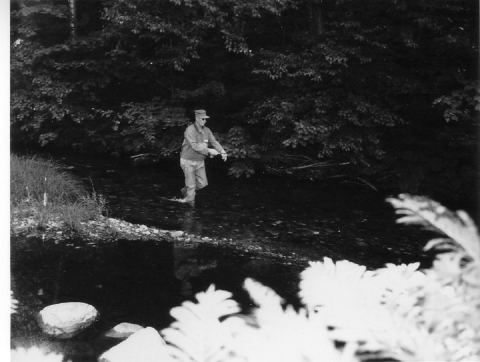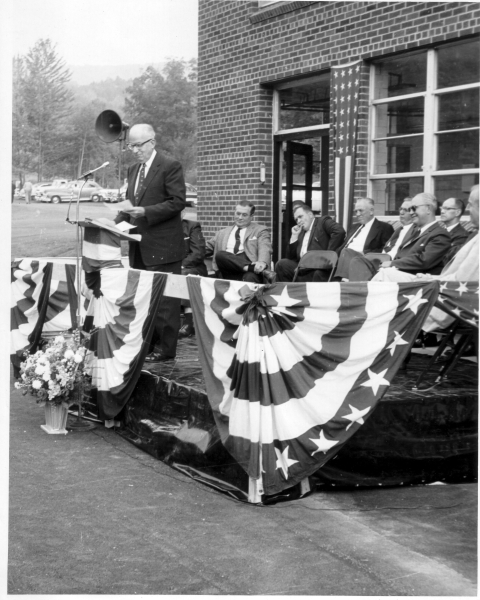About Us
Our hatchery lies on 35-acres in the Green Mountains of Vermont. The hatchery was authorized by Congress in 1906 and constructed in 1909 to produce brook trout, char and Atlantic salmon for stocking the waters of Vermont, New York, and New Hampshire. The primary water supply, Furnace Brook, is a clean, soft water stream with high oxygen content. It also provides the seasonal fluctuations in temperature, hardness, and pH that closely approximate what the fish would encounter in nature. This results in fish better adapted to their natural environment.
We have been rearing landlocked Atlantic salmon for anglers in the Lake Champlain basin for over one hundred. Additionally, we raise lake and brook trout for anglers and the recreational fishery in the Great Lakes and Lake Champlain.
Fishing is a traditional use of the National Fish Hatchery System. At our hatchery, we welcome people of all backgrounds and abilities to participate in recreational fishing.
Our hatchery is open to visitors to enjoy the grounds, and view of our fish. We also offer tours to groups as time allows within our fish-rearing duties; please call ahead so we can put you on our schedule.
Our History
Funds for the Dwight D. Eisenhower National Fish Hatchery (formerly the Pittsford National Fish Hatchery) were authorized by Congress 34 Statute 721, June 30, 1906. That year, the U. S. Bureau of Fisheries built a small rearing station to grow brook trout during the summer months. For three years, fish were grown in sixty wooden troughs supplied with water from Furnace Brook and natural springs.
In 1909, land was purchased and the hatchery opened for the production of salmonids (trout, char, and salmon). From 1925-1940, it was an experimental station focusing on culture of new species, fish nutrition, and selective breeding. The hatchery raised California golden trout, cutthroat trout, rainbow trout, brown trout, Loch Levlen trout, lake trout, brook trout, Arctic char, and Arctic grayling. Some of the earliest work on the survival of stocked trout and fishing pressure came from studies conducted from 1935-1945 under the direction of Mr. Russel Lord, hatchery manager.
In 1955, President Eisenhower visited the hatchery and was guided by Manager Ben Schley on a fishing trip to Furnace Brook, which is the source of the water supply to the hatchery. The hatchery was later rebuilt entirely beginning in 1956, and production resumed in 1959 producing trout for Northeastern States of Vermont, New Hampshire, Maine, New York, Massachusetts, Connecticut, Rhode Island, Pennsylvania, and New Jersey.
Then in 1968, the hatchery began raising sea-run Atlantic salmon for the Connecticut River Restoration Program. And in 1974, the first salmon in over a century returned up the river to spawn. The first tagged salmon - tagged by Mrs. Katherine Sivret of Chittenden, Vermont - to ascend the Connecticut River was produced at the Eisenhower National Fish Hatchery, as were most of the adult returns to the Connecticut River. The Connecticut River salmon program was ended in 2014.
The hatchery began raising landlocked Atlantic salmon and lake trout for the Lake Champlain Restoration Program in 1980. These two species were extirpated from Lake Champlain around the turn of the century, but there is now a thriving fishery in the lake. More recently, we expanded our lake trout rearing to help restore the fishery in Lake Ontario and Lake Erie. The station also raises brook trout for Vermont waters.
Between 1999 and 2004, hatchery staff assisted New York with lake sturgeon production, a threatened species in New York, for release into the St. Lawrence River and Finger Lakes.
In 2009, we changed the name of the hatchery from the Pittsford National Fish Hatchery to the Dwight D. Eisenhower National Fish Hatchery, in honor of our 34th president.
Eisenhower (Pittsford) raised approximately 60% of the landlocked salmon produced for Lake Champlain from 1980 to 2005. In 1991, an estimated 10,000 anglers spent 566,202 days in pursuit of the landlocked salmon on Lake Champlain, contributing 50 million dollars to the region's economy.
The hatchery’s gravity-fed water supply is not pumped or chilled, making it one of the least expensive hatcheries in operating costs.

